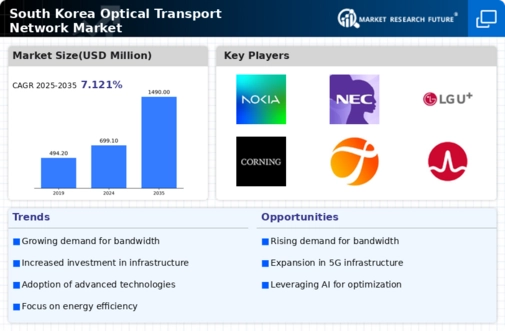Emergence of 5G Technology
The rollout of 5G technology in South Korea significantly impacts the optical transport-network market. With the increasing deployment of 5G infrastructure, there is a heightened demand for optical transport solutions that can support the high data rates and low latency required by next-generation mobile networks. The optical transport-network market is likely to see a substantial increase in investments as telecom operators upgrade their networks to accommodate 5G capabilities. In 2025, it is estimated that the market will witness a growth rate of around 15%, primarily driven by the need for enhanced bandwidth and reliability. This transition to 5G not only transforms consumer experiences but also opens new avenues for businesses, further propelling the optical transport-network market.
Government Initiatives and Support
The South Korean government plays a crucial role in fostering the optical transport-network market through various initiatives and support programs. Policies aimed at enhancing digital infrastructure and promoting technological innovation are likely to stimulate market growth. For instance, the government has allocated substantial funding to improve broadband access in rural areas, which is expected to increase the adoption of optical transport solutions. Additionally, regulatory frameworks that encourage competition among service providers may lead to enhanced service offerings and lower prices for consumers. As a result, the optical transport-network market benefits from a conducive environment that encourages investment and innovation, ultimately driving growth and development.
Growing Data Traffic and Cloud Services
The optical transport-network market in South Korea is significantly influenced by the exponential growth of data traffic and the increasing reliance on cloud services. As businesses and consumers generate vast amounts of data, the demand for efficient data transmission solutions intensifies. In 2025, data traffic is expected to increase by over 30%, necessitating the adoption of advanced optical transport technologies to manage this surge effectively. The optical transport-network market is likely to benefit from this trend, as service providers seek to enhance their network capabilities to support cloud-based applications and services. This growing reliance on cloud infrastructure not only drives demand for optical transport solutions but also encourages innovation within the industry.
Focus on Network Security and Reliability
In an era where cyber threats are increasingly prevalent, the optical transport-network market in South Korea is witnessing a heightened focus on network security and reliability. As organizations prioritize the protection of sensitive data, there is a growing demand for optical transport solutions that offer enhanced security features. The optical transport-network market is likely to evolve in response to these needs, with providers investing in technologies that ensure secure data transmission and minimize downtime. This emphasis on security is expected to drive market growth, as businesses seek to safeguard their operations against potential threats while maintaining high levels of service reliability. Consequently, the optical transport-network market is positioned to adapt and thrive in this dynamic landscape.
Rising Demand for High-Speed Connectivity
The optical transport-network market in South Korea experiences a notable surge in demand for high-speed connectivity. As digital transformation accelerates across various sectors, including telecommunications and cloud services, the need for robust and efficient data transmission becomes paramount. In 2025, the market is projected to grow at a CAGR of approximately 12%, driven by the increasing reliance on high-bandwidth applications such as 5G networks and IoT devices. This demand compels service providers to invest in advanced optical transport solutions, enhancing their infrastructure to meet consumer expectations. Consequently, the optical transport-network market is poised for significant expansion, as businesses seek to leverage faster and more reliable connectivity to improve operational efficiency and customer satisfaction.
















